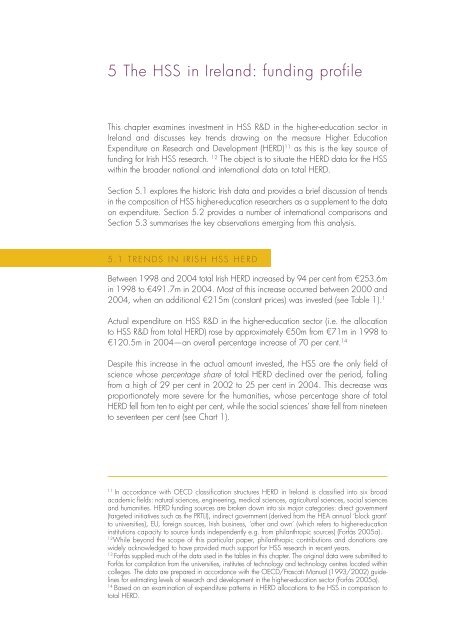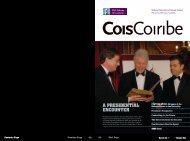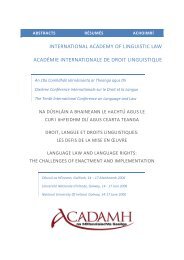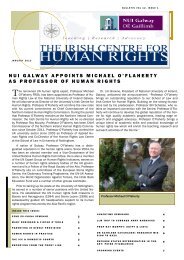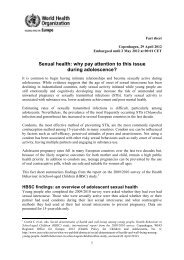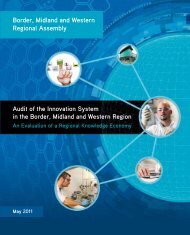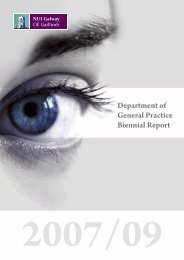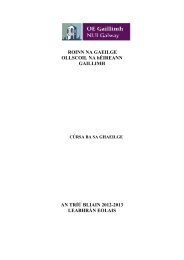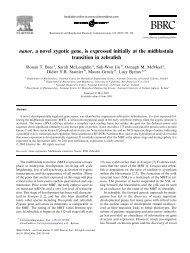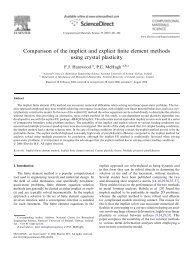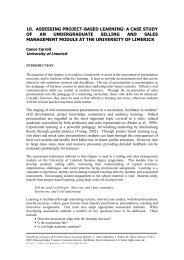Advancing Humanities and Social Sciences Research in Ireland
Advancing Humanities and Social Sciences Research in Ireland
Advancing Humanities and Social Sciences Research in Ireland
You also want an ePaper? Increase the reach of your titles
YUMPU automatically turns print PDFs into web optimized ePapers that Google loves.
5 The HSS <strong>in</strong> Irel<strong>and</strong>: fund<strong>in</strong>g profile<br />
This chapter exam<strong>in</strong>es <strong>in</strong>vestment <strong>in</strong> HSS R&D <strong>in</strong> the higher-education sector <strong>in</strong><br />
Irel<strong>and</strong> <strong>and</strong> discusses key trends draw<strong>in</strong>g on the measure Higher Education<br />
Expenditure on <strong>Research</strong> <strong>and</strong> Development (HERD) 11 as this is the key source of<br />
fund<strong>in</strong>g for Irish HSS research. 12 The object is to situate the HERD data for the HSS<br />
with<strong>in</strong> the broader national <strong>and</strong> <strong>in</strong>ternational data on total HERD.<br />
Section 5.1 explores the historic Irish data <strong>and</strong> provides a brief discussion of trends<br />
<strong>in</strong> the composition of HSS higher-education researchers as a supplement to the data<br />
on expenditure. Section 5.2 provides a number of <strong>in</strong>ternational comparisons <strong>and</strong><br />
Section 5.3 summarises the key observations emerg<strong>in</strong>g from this analysis.<br />
5.1 TRENDS IN IRISH HSS HERD<br />
Between 1998 <strong>and</strong> 2004 total Irish HERD <strong>in</strong>creased by 94 per cent from 253.6m<br />
<strong>in</strong> 1998 to 491.7m <strong>in</strong> 2004. Most of this <strong>in</strong>crease occurred between 2000 <strong>and</strong><br />
2004, when an additional 215m (constant prices) was <strong>in</strong>vested (see Table 1). 1<br />
Actual expenditure on HSS R&D <strong>in</strong> the higher-education sector (i.e. the allocation<br />
to HSS R&D from total HERD) rose by approximately 50m from 71m <strong>in</strong> 1998 to<br />
120.5m <strong>in</strong> 2004—an overall percentage <strong>in</strong>crease of 70 per cent. 14<br />
Despite this <strong>in</strong>crease <strong>in</strong> the actual amount <strong>in</strong>vested, the HSS are the only field of<br />
science whose percentage share of total HERD decl<strong>in</strong>ed over the period, fall<strong>in</strong>g<br />
from a high of 29 per cent <strong>in</strong> 2002 to 25 per cent <strong>in</strong> 2004. This decrease was<br />
proportionately more severe for the humanities, whose percentage share of total<br />
HERD fell from ten to eight per cent, while the social sciences’ share fell from n<strong>in</strong>eteen<br />
to seventeen per cent (see Chart 1).<br />
11<br />
In accordance with OECD classification structures HERD <strong>in</strong> Irel<strong>and</strong> is classified <strong>in</strong>to six broad<br />
academic fields: natural sciences, eng<strong>in</strong>eer<strong>in</strong>g, medical sciences, agricultural sciences, social sciences<br />
<strong>and</strong> humanities. HERD fund<strong>in</strong>g sources are broken down <strong>in</strong>to six major categories: direct government<br />
(targeted <strong>in</strong>itiatives such as the PRTLI), <strong>in</strong>direct government (derived from the HEA annual ‘block grant’<br />
to universities), EU, foreign sources, Irish bus<strong>in</strong>ess, ‘other <strong>and</strong> own’ (which refers to higher-education<br />
<strong>in</strong>stitutions capacity to source funds <strong>in</strong>dependently e.g. from philanthropic sources) (Forfás 2005a).<br />
12<br />
While beyond the scope of this particular paper, philanthropic contributions <strong>and</strong> donations are<br />
widely acknowledged to have provided much support for HSS research <strong>in</strong> recent years.<br />
13<br />
Forfás supplied much of the data used <strong>in</strong> the tables <strong>in</strong> this chapter. The orig<strong>in</strong>al data were submitted to<br />
Forfás for compilation from the universities, <strong>in</strong>stitutes of technology <strong>and</strong> technology centres located with<strong>in</strong><br />
colleges. The data are prepared <strong>in</strong> accordance with the OECD/Frascati Manual (1993/2002) guidel<strong>in</strong>es<br />
for estimat<strong>in</strong>g levels of research <strong>and</strong> development <strong>in</strong> the higher-education sector (Forfás 2005a).<br />
14<br />
Based on an exam<strong>in</strong>ation of expenditure patterns <strong>in</strong> HERD allocations to the HSS <strong>in</strong> comparison to<br />
total HERD.


